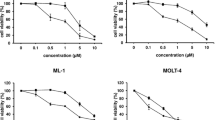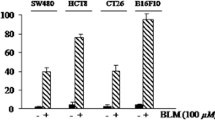Abstract
Objective
The inhibitory action of fMLP-boanmycin (BAM) combination on the growth of mouse colon carcinoma and its action mechanisms were observed in order to provide experimental proof for probing novel regimen of chemotactic modulation in combination with chemotherapy in the treatment of cancer.
Methods
Cytotoxicity of BAM-fMLP combination to tumor cells was determined by MTT assay in vitro. Antitumor activity of BAM-fMLP combination was assessed in mice subcutaneously transplanted colon carcinoma 26. The amount of superoxide anion \( \left( {O_2 ^{_ \bullet ^ - } } \right) \) released from fMLP stimulated macrophages was determined by NBT assay. The amount of nitric oxide (NO) was indirectly determined by Griess method.
Results
BAM-fMLP combination had no synergistic effect on tumor cells(CDI>0.85), but BAM at the doses of 10μg/ml, 30μg/ml and 100μg/ml in combination with fMLP at the concentration 20μg / ml exhibited synergistic effect on tumor cells in the presence of macrophages(CDI<0.75). fMLP inhibited the growth of colon carcinoma 26 by 50.0% when it at dose of 1 mg/mouse was administered peritumorally. BAM (1 mg/kg, intraperitoneally, three times) alone and BAM — fMLP combination inhibited the growth of colon carcinoma 26 by 38.6% and 78.4%, respectively (CDI=0.71) on day 12. The amount of \( O_2 ^{_ \bullet ^ - } \) released from fMLP 4.6×10−7 mol/L (0.2μg/ml) stimulated macrophages which were treated by BAM in vitro increased significantly(P<0.01). fMLP 2.3×10−6 mol/L (1μg/ml) could not stimulate macrophages to release NO, but may stimulate macrophages treated with BAM 10μg/ml and 100μg/ml to release NO significantly(P<0.01).
Conclusion
The inhibitory action of fMLP-boanmycin combination on the growth of mouse colon carcinoma have synergism, which may associate with the increase of \( O_2 ^{_ \bullet ^ - } \) and NO released by macrophages. Chemotactic modulation in combination with chemotherapy may be a novel regimen in the treatment of cancer.
Similar content being viewed by others
References
Melani C, Pupa SM, Stoppacciaro A, et al. An in vivo model to compare human leukocyte infiltration in carcinoma xenografts producing different chemokines [J]. Int J Cancer 1995; 62: 572–578.
Opdenakker G, Van Damme J. Chemotactic factors, passive invasion and metastasis of cancer cells[J]. Immunol Today 1992; 13: 463–464.
Wang JM, Chertov O, Proost P, et al. Purification and identification of chemokines potentially involved in kidney-specific metastasis by a murine lymphoma variant: induction of migration and NFκB activation[J]. Int J Cancer 1998; 75: 900–907.
Gebhard B, Gnant M, Schutz G, et al. Different transendothelial migration behaviour pattern of blood monocytes derived from patients with benign and malignant disease of the breast[J]. Anticancer Res 2000; 20(6B): 4599–4604.
Chester JF, Ross JS, Malt RA, et al. Acute colitis produced by chemotactic peptides in rats and mice[J]. Am J Pathol 1985; 121: 284–290.
Zhang L, Khayat A, Cheng H, et al. The pattern of monocyte recruitment in tumors is modulated by MCP-1 expression and influences the rate of tumor growth[J]. Lab Invest 1997; 76: 579–590.
Ottonello L, Morone P, Mancini M, et al. fMLP-and TNF-stimulated monoclonal Lym-1 antibodydependent lysis of B lymphoblastoid tumor targets by neutrophils[J]. Br J Cancer 1999; 80: 331–337.
Ottonello L, Morone P, Dapino P, et al. Monoclonal Lym-1 antibody dependent lysis of B-lymphoblastoid tumor targets by human complement and cytokinineexposed mono-nuclear and neutrophilic polymorphonuclear leukocytes[J]. Blood 1996; 87: 5171–5178.
Jiang M, Zhen YS. Antitumor activity of bleomycin A6 against human liver cancer in cell culture and in nude mice[J]. Yao Xue Xue Bao(in Chinese) 1987; 22: 881–885.
Deng YC, Zhen YS, Zheng S, et al. Inhibitory effect of bleomycin A6 on human colon cancer xenografts in nude mice[J]. Zhongguo Yi Xue Ke Xue Yuan Xue Bao(in Chinese) 1990; 12: 335–340.
Liu XJ, Li Y, Zhen YS. Inhibitory effect of boanmycin on the growth of colon carcinoma and hepatic metastasis in mice[J]. Yao Xue Xue Bao(in Chinese) 2001; 36: 14–18.
Yuan L, Kobayashi M, Kuramitsu Y. Restoration of macrophage tumoricidal activity by bleomycin correlates with the decreased production of transforming growth factor β in rats bearing KDH-8 hepatoma cells[J]. Cancer Immunol Immunother 1997; 45: 71–76.
Bryant SM, Lynch RE, Hill HR. Kinetic analysis of superoxide anion production by activated and resident murine peritoneal macrophages[J]. Cell Immunol 1982; 69: 46–58.
Nielsen H. Antibiotics and human monocyte function I. Chemotaxis[J]. Acta Pathol Microbiol Immunol Scand B 1987; 95: 293–296.
Cao SS, Zhen YS. Potentiation of antimetabolite antitumor activity in vivo by dipyridamole and amphotericin B[J]. Cancer Chemother Pharmacol 1989; 24: 181–186.
Leiper K, Campbell BJ, Jenkinson MD, et al. Interaction between bacterial peptides, neutrophils and goblet cells: a possible mechanism for neutrophil recruitment and goblet cell depletion in colitis[J]. Clin Sci (Lond) 2001; 101: 395–402.
Sodhi A, Biswas SK. fMLP-induced in vitro nitric oxide production and its regulation in murine peritoneal macrophages[J]. J Leukoc Biol 2002; 71: 262–270.
Ma Y, Wang M, Li N, et al. Bleomycin-induced nuclear factor-kappaB activation in human bronchial epithelial cells involves the phosphorylation of glycogen synthase kinase 3 beta[J]. Toxicol Lett 2009; 187:194–200.
Author information
Authors and Affiliations
Corresponding author
Rights and permissions
About this article
Cite this article
Li, Zd., Gao, Y. Synergistic action of fMLP-boanmycin combination on the growth of mouse colon carcinoma and its action mechanisms. Chin. J. Cancer Res. 22, 135–140 (2010). https://doi.org/10.1007/s11670-010-0135-3
Received:
Accepted:
Published:
Issue Date:
DOI: https://doi.org/10.1007/s11670-010-0135-3




